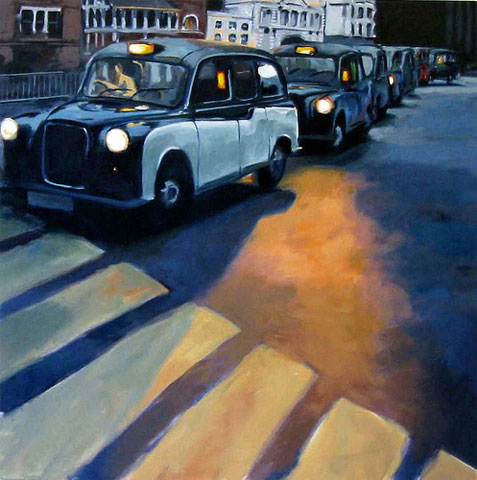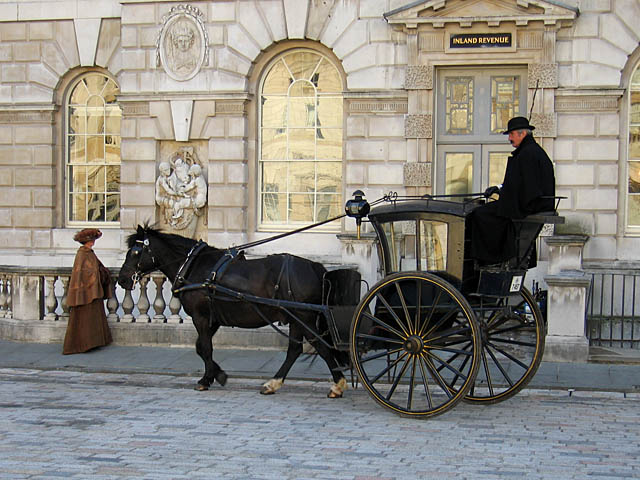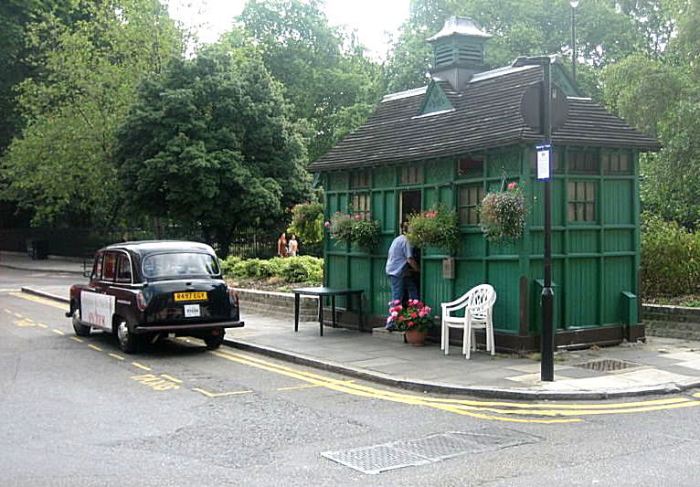Most visitors coming to London will be familiar with the ‘icon’ of The Black Taxi, but few know anything of its history.
Oil painting by Nathaniel Fowles.
The earliest public vehicles were horse drawn Hackney carriages which first appeared during the reign of Queen Elizabeth 1 and were licensed from 1639. The first person to start a taxi service was Captain Bailey, a veteran from St Walter Raleigh’s expeditions to the ‘New World’. Other entrepreneurs followed suit and by 1760 there were 1,000 ‘Hackney Hell Carts’ causing congestion and chaos in the city. All Hackney drivers were obliged by law to carry a bale of hay to feed their horses and curiously this law continued for a time even after cabs were motorised in 1908. Even today I meet some cabbies who still carry a very small bale of hay in their trunk as a symbolic gesture to their colourful past.
In 1823 two wheeled ‘cabriolets’ were imported from France. These, being French, were more elegant and provided a smoother ride. They gave their name to the ‘cab’. However In 1840 a British version was designed by Joseph Hansom, an architect from York. His Hansom cabs were popular, being lighter, safer and easier to negotiate than the Hackney carriages and they could also be pulled by only one horse. Prime Minister Benjamin Disraeli called them ‘The gondolas of London’.
A cabriolet.
All these early vehicles were open to the elements – the driver sitting on top regardless of the weather. The only places where he could stop for sustenance were public houses (pubs) which necessitated paying someone to stand outside to guard his horse and cab.
In 1875 a Captain Armstrong, Editor of ‘The Globe’, urgently needed to get to his office in Fleet Street. At that time some 4,600 cabbies were plying for trade in London. He sent his manservant out in a terrible storm to find one. An hour later he returned, soaked to the skin, having found several drivers in pubs, all in various states of inebriation. Armstrong decided something must be done. The Temperance Movement was then in full swing (against excessive imbibing of alcohol) – so he, together with other well meaning philanthropists, set up a charity to build Cabmen’s Shelters where drivers could obtain ‘good, wholesome food at reasonable prices’. Forty-seven were constructed within a six mile radius of Charing Cross Station, which is to this day regarded as the hub of London – all distances in London being measured from Charing Cross.
There were strict rules concerning both their construction and usage. They could be no longer in size than the original horse and cart. There was a wood burning stove inside and railings outside to tether horses. Food was available but absolutely no alcohol was permitted, nor could drivers swear, play cards or indulge in any other form of gambling or discuss politics. With all these restrictions it is surprising that they became so popular – obviously the way to a taxi driver’s heart was through his stomach. The shelters seated a maximum of eleven men.
Today thirteen of these huts still exist. Anyone can buy a drink or food but seats inside are solely for those cabbies who have completed the ‘Knowledge’ – an exam that has been in place since 1884.
London cabbies are renowned for their encyclopaedic grasp of the city, but this does not come easily. They must master a minimum of 320 routes, learn the location of more than 25,000 streets and 20,000 landmarks and in particular know the quickest route to get from point A to B. This process, called ‘The Knowledge’, can take up to five years to complete. Trainees receive a ‘Blue Book’ of test routes and are regularly seen riding scooters or motorbikes around the city with their clipboards. They take a series of written and oral tests that are considered to be one of the most taxing( sorry about that!) exams in existence, demanding thousands of hours of study and total commitment.
Neuroscientists at University College Hospital, London undertook a 15 year research project which proved that part of the brain – the hippocampus, fundamental for memory retention, is larger in London taxi drivers than in other people.
One shining example was Fred Housego, a cabbie who, in 1980, was seen by 18 million viewers when he won ‘Mastermind’ and then proceeded to have a successful career on radio and t.v. But he never relinquished his cab license and was still driving in 2007.
The present day black cab was first produced in 1958. Oil magnate Gulbenkian bought one in the sixties as “It can turn on a sixpence – whatever that is.” Cabs were also built to a height that could accommodate wearers of top hats and bowlers – a common sight in the city in those days.
Driving a cab was always a working class occupation. The majority came from East London, the Irish and later the Jews. Jewish boys were considered good candidates as they drank little alcohol. Becoming a cabbie was the ideal way that boys with little education could progress – their cab was, literally, a vehicle of upward mobility.
In 2004 The Worshipful Company of Hackney Carriage Drivers became the 104th Livery company of the city of London and was presented with a Royal Charter by Prince Charles. I recall when a dear cabbie friend of mine was invited to the inaugural ceremony and the pride he felt that his occupation had been honoured in this way.
Oil painting by Nathaniel Fowles.
There is no question that cabbies hold a significant place in the traditions and culture of London. For this reason it is sad that they are now under attack from newer public transport systems using gps.
Black cabs are still the only transport that can be legally hailed on the street. You flag them down with a wave of your arm – you should never shout ‘taxi!’ – this is illegal and the taxi is not obliged to stop. I wonder how many tourists or residents are aware of this. Boris Johnson the Mayor of London stated that London’s black cab trade is crucial to the “fabric of the city” but at the same time he is encouraging new technology as proposed by companies such as Uber.
My vote goes without question to the black cabs. My GPS is invariably wrong, and in any event it simply cannot compete with the experience of a real cabbie.
When you next go to London, ride in a black cab, engage with the driver and see how it enhances your trip. You should also visit one of their shelters, experience a piece of true London and meet real Londoners. At the very least it is worth going for a cup of tea for only 60p. I hope that both the shelters and the cabbies will be around for many more years.




A real insight Ruth, brilliant as usual!
LikeLike
Thanks I am now working on book 2 in Israel and also started on Unexpected London. Glad you approve.
LikeLike
Fascinating piece of social and economic history.
LikeLike
I love London – so I really loved this piece Ruth. Brought lots of memories back to me! Looking forward very much to your next pieces – and also to your book. Congratulations on the publication.
LikeLike
ruth I absolutely love this story. I knew some of it but not the bit about the hay! considering that I’m a horse lover and rider I should have known that little fact.
love
m
LikeLike
Ruth, I so enjoyed this. It is so full of fascinating knowledge, told in your usual lively, interesting way. I also loved the piece about the hay!.
LikeLike
fascinating, Ruth, but do you also know that Black cabs ( not all of which are black) are also wheelchair accessible making itr so much easier for the disabled to get around London
LikeLike
yes I know about this, also about the multicoloured cabs, but they are still called ‘black’ cabs. we are great traditionalists in London.!
LikeLike
Congratulations Ruth on this warm, interesting and historically fascinating new addition to your library or Interesting …. I do hope a London book comes out before the next Israel book does. xxx
LikeLike